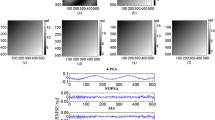Abstract
The phase interferometer is an effective direction finding (DF) method. It is widely utilized in various electronic reconnaissance systems due to its advantages of fast operation and high precision. In a wideband system, the combination of long and short baselines, or even multi-level baselines, is applied in an interferometer to solve the contradiction between accuracy and phase ambiguity for DF. In this paper, a novel analysis method is proposed to obtain the probability of successfully solving ambiguity based on mathematical statistics. According to the length ratio between short and long baselines, the joint density function of phase errors can be derived. Then, the probability can be achieved under different signal-to-noise ratios (SNRs) by integrating the joint density function in a specific interval. Furthermore, the formula of phase measurement error is adjusted by the least square method to improve computational accuracy in low SNR during the process. Under different baseline configurations, the strategy can provide the theoretical probability of successfully solving ambiguity, thus guiding the baseline design for obtaining a maximum probability without impacting the specified DF accuracy. Simulation results show that the mathematical model is efficient in some complex cases.



















Similar content being viewed by others
Availability of data and materials
The datasets generated during and analysed during the current study are available from the corresponding author on reasonable request.
References
L. Balogh, I. Kollar, Angle of arrival estimation based on interferometer principle, in IEEE International Symposium on Intelligent Signal Processing, 2003, pp. 219–223 (2003)
D. Ciuonzo, G. Romano, R. Solimene, Performance analysis of time-reversal MUSIC. IEEE Trans. Signal Process. 63(10), 2650–2662 (2015)
C. El Kassis, J. Picheral, G. Fleury, C. Mokbel, Direction of arrival estimation using EM-ESPRIT with nonuniform arrays. Circuits Syst. Signal Process. 31(5), 1787–1807 (2012)
J.H. Ender, On compressive sensing applied to radar. Signal Process. 90(5), 1402–1414 (2010)
C. He, J. Chen, X. Liang, J. Geng, W. Zhu, R. Jin, High-accuracy DOA estimation based on time-modulated array with long and short baselines. IEEE Antennas Wirel. Propag. Lett. 17(8), 1391–1395 (2018)
E.J. Holder, Angle-of-Arrival Estimation Using Radar Interferometry: Methods and Applications (SciTech Publishing, Raleigh, 2014)
E. Jacobs, E.W. Ralston, Ambiguity resolution in interferometry. IEEE Trans. Aerospace Electron. Syst. AES–17(6), 766–780 (1981)
M. Jin, G. Liao, J. Li, Joint DOD and DOA estimation for bistatic MIMO radar. Signal Process. 89(2), 244–251 (2009)
S. Kawase, Radio interferometer for geosynchronous-satellite direction finding. IEEE Trans. Aerospace Electron. Syst. 43(2), 443–449 (2007)
R. Krummenauer, R. Ferrari, R. Suyama, R. Attux, C. Junqueira, P. Larzabal, P. Forster, A. Lopes, Maximum likelihood-based direction-of-arrival estimator for discrete sources. Circuits Syst. Signal Process. 32(5), 2423–2443 (2013)
W. Lan-Mei, L. Ji-Ping, W. Gui-Bao, C. Zhi-Hai, A direction finding technique using millimeter wave interferometer. J. Infrared Millim. Waves 34(2), 140–144 (2015)
J.H. Lee, J.M. Woo, Interferometer direction-finding system with improved DF accuracy using two different array configurations. IEEE Antennas Wirel. Propag. Lett. 14, 719–722 (2015)
J.H. Lee, J.H. Lee, J.M. Woo, Method for obtaining three- and four-element array spacing for interferometer direction-finding system. IEEE Antennas Wirel. Propag. Lett. 15, 897–900 (2016)
J.H. Lee, J.K. Kim, H.K. Ryu, Y.J. Park, Multiple array spacings for an interferometer direction finder with high direction-finding accuracy in a wide range of frequencies. IEEE Antennas Wirel. Propag. Lett. 17(4), 563–566 (2018)
C. Li, Z. Chen, X. Wu, A scheme to measure lateral velocity by radio interferometry. IEEE Geosci. Remote Sens. Lett. 13(2), 127–131 (2016)
Z.M. Liu, F.C. Guo, Azimuth and elevation estimation with rotating long-baseline interferometers. IEEE Trans. Signal Process. 63(9), 2405–2419 (2015)
A. Massa, P. Rocca, G. Oliveri, Compressive sensing in electromagnetics-a review. IEEE Antennas Propag. Mag. 57(1), 224–238 (2015)
P. Pace, D. Wickersham, D. Jenn, N. York, High-resolution phase sampled interferometry using symmetrical number systems. IEEE Trans. Antennas Propag. 49(10), 1411–1423 (2001)
L. Ping, W. Guohong, X. Yan, G. Peng, W. Shi, L. Jian, A single-station location method based on long baseline interferometer, in 2014 14th International Symposium on Communications and Information Technologies (ISCIT), pp. 332–335 (2014)
D. Romero, D.D. Ariananda, Z. Tian, G. Leus, Compressive covariance sensing. IEEE Signal Process. Mag. 33(1), 78–93 (2016)
L.V. Stephen Boyd, Convex Optimization (Cambridge University Press, Cambridge, 2004)
M. Wang, A. Nehorai, Coarrays, MUSIC, and the Cramer–Rao bound. IEEE Trans. Signal Process. 65(4), 933–946 (2017)
Z. Wang, A. Sinha, P. Willett, Y. Bar-Shalom, Angle estimation for two unresolved targets with monopulse radar. IEEE Trans. Aerospace Electron. Syst. 40(3), 998–1019 (2004)
Acknowledgements
The authors are grateful to the anonymous reviewers and the editor for their careful work. This work was supported by the Fundamental Research Funds for the Central Universities in Key Laboratory of Advanced Marine Communication and Information Technology (No. 3072020CF0815).
Author information
Authors and Affiliations
Corresponding author
Ethics declarations
Conflict of interest
The authors declare that they have no conflict of interest.
Additional information
Publisher's Note
Springer Nature remains neutral with regard to jurisdictional claims in published maps and institutional affiliations.
Rights and permissions
About this article
Cite this article
Liu, L., Yu, T. An Analysis Method for Solving Ambiguity in Direction Finding with Phase Interferometers. Circuits Syst Signal Process 40, 1420–1437 (2021). https://doi.org/10.1007/s00034-020-01536-1
Received:
Revised:
Accepted:
Published:
Issue Date:
DOI: https://doi.org/10.1007/s00034-020-01536-1




